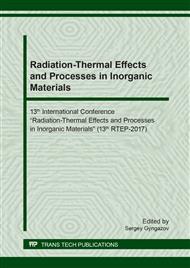[1]
G.N. Makarov, Experimental methods for determining the temperature and heat of fusion of clusters, UFN. 2010. 180(2). p.185–207.
Google Scholar
[2]
N.T. Gladkich, R. Niedermayer, K. Spiegel, Nachweis groser Schmelzpunktserniedrigungen bei d¨unnen Metallschichten, Phys. Stat. Solidi. 1966. 15. p.181–203.
DOI: 10.1002/pssb.19660150116
Google Scholar
[3]
G. Melnikov, S. Yemelianov, N. Ignatenko, E. Cherkasov, O. Manzhos, Cluster melting in effective potential model, IOP Conference Series: Materials Science and Engineering 168 (2017) 012021.
DOI: 10.1088/1757-899x/168/1/012021
Google Scholar
[4]
C.C. Yang, M.X. Xiao, W.Lic, Q. Jiang, Size effects on Debye temperature, Einstein temperature, and volume thermal expansion coefficient of nanocrystals, Solid State Communications 139 (2004) p.148–152.
DOI: 10.1016/j.ssc.2006.05.035
Google Scholar
[5]
D.J. Wales, The Cambridge Cluster, Information on http://www-wales.ch.cam.ac.uk/CCD.htm.
Google Scholar
[6]
Y. Evtushenko, M. Posypkin, A deterministic algorithm for global multi-objective optimization, Optimization Letters7(4)(2013) p.819–829.
DOI: 10.1080/10556788.2013.854357
Google Scholar
[7]
G. Melnikov, Heat of Melting of Small Clusters in the Model of the Potential with the Effective Well Depth, Solid State Physics 60(5)(2018) p.1000–1004.
DOI: 10.1134/s1063783418050207
Google Scholar
[8]
A. Siber, Vibrations of closed-shell Lennard-Jones icosahedral and cuboctahedral clusters and their effect jn the cluster ground-state energy, Phys. Rev. B 70(2004) 075407.
DOI: 10.1103/physrevb.70.075407
Google Scholar
[9]
J.P.K. Doye, D.J. Wales, R.S. Berry, The effect of the range of the potential on the structures of clusters, J. Chem. Phys. 103(10) (1995) 4236.
Google Scholar
[10]
H. Xu, B.J. Berne, Multicanonical jump walk annealing: An efficient method for geometric optimization, J. Chem. Phys. 112(6) (2000) p.2701–2708.
DOI: 10.1063/1.480844
Google Scholar
[11]
G.Melnikov, The quasicrystal model of cluster systems in condensed matter, IOP Conference Series: Materials Science and Engineering168 (2017) 012020.
DOI: 10.1088/1757-899x/168/1/012020
Google Scholar
[12]
D.S. Bertoldi, E.N. Millán, A.F. Guillermet, Thermodynamics of the melting process in Au nano-clusters: Phenomenology, energy, entropy and quasi-chemical modeling, Journal of Physics and Chemistry of Solids111(2017) p.286–293.
DOI: 10.1016/j.jpcs.2017.08.010
Google Scholar
[13]
N. Cruz, M. Olivares, The golden ratio in Schwarzschild–Kottler black holes, European Physical Journal C 77(2) (2017) 123.
DOI: 10.1140/epjc/s10052-017-4670-7
Google Scholar


